-
Posts
1,025 -
Joined
-
Last visited
Content Type
Profiles
Forums
Store
Help Articles
Posts posted by albiston
-
-
April,
Great looking Jota!
I too think lima beans are a mis-translation. I spent a couple of years very close to Trieste during my teens and as far, as I can remember, every time I had Jota there it was made with borlotti beans, which I believe are cranberry beans in the US.
You mention brovade: are you planning to prepare those from scratch? That would be impressive!
-
Don Alfonso is always a good bet.
I disagree with vinobiondo about Torre del Saracino, as we have had chance to discuss in the past, both about the quality and the prices, but I think that's just the way it is with this restaurant: some people love it some don't see what the fuss is about. Furthermore Esposito might have closed his restaurant to head the kitchen of the nearby Crown Plaza Hotel, though I have no certain news about that.
Two destinations that might be worth seeking out are "Taverna del Capitano", in Nerano, and "Il Buco" in Sorrento: both have their fans and get pretty good press.
Or are you're looking for something slightly more in the direction of traditional local cooking?
-
Alberto: Of course, your most recent meal looks beautiful. I am wondering if you have ever made polenta using buckwheat flour (what is the Italian word for that grain)? From what I understand, buckwheat was used in certain parts of Lombardia before corn came to Italy.
You are right Elizabeth, buckwheat is still a staple in the cuisine of Valtellina, though most of what's used in cooking today comes from China since growing buckwheat in the alpine valleys is hardly profitable.
I don't know if there's a polenta made with 100% buckwheat flour, though that would not surprise me. What I've eaten a few times is polenta taragna which is made with a mixture of maize and buckwheat meal. I know that a few recipes call for buckwheat flour, but whenever I have seen buckwheat for polenta on sale it was definitely not as finely ground as flour would be, so I am a little confused.
-
Some cooking from early last week. Given the nice snowy weather we had here in Thuringia, a polenta dinner seemed just the right thing.
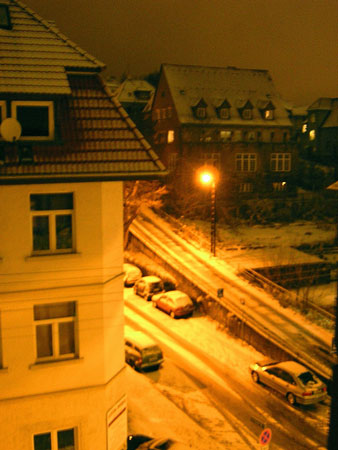
I made polenta, for once, the traditional ways: stirring the cooking cornmeal porridge constantly (or almost) for a good hour. My arms were just a wee bit sore the next morning; at least now I understand why those old women from the Alps regions have such extraordinary biceps. Compared with the instant stuff polenta made the traditional way definitely has a better texture and more aromatic taste.
To go with the polenta I we had some Taleggio, funghi trifolati (pan cooked mushrooms flavoured with plenty of garlic and parsley) and luganega al sugo (luganega cooked in a little tomato, onion and red wine sauce). I made the luganega using the recipe Adam posted before, but having no casings at hand I just turned the force-meat into small meatballs: the recipe works great, definitely the right flavour, though I would maybe add a tiny bit more Parmesan.
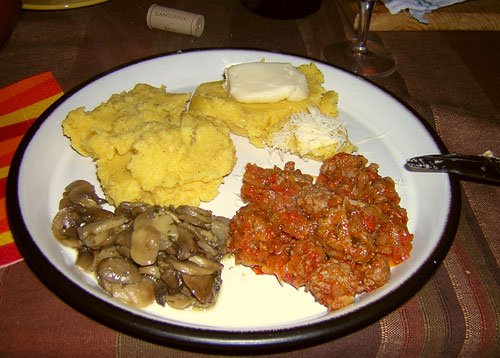
At the last moment I also made some costine con salasa alla diavola, pork ribs with "devil's" sauce, using the same recipe I mentioned in the riso alla pilota post. This time they went with a simple green sauce made of flat leafed parsley, garlic, lemon juice, vinegar and olive oil.
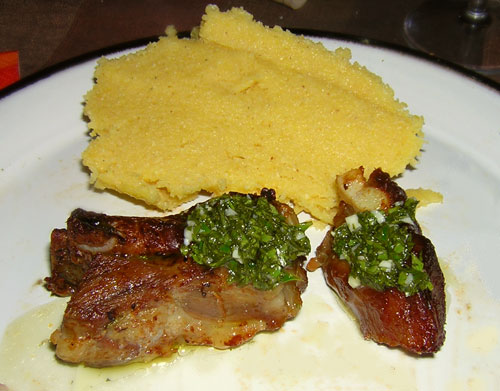
-
What could be better than having our very own Amsterdam insider sharing her tips with us!
Still, as Klary perfectly put it in her opening post, please do not shy away from adding your own Amsterdam food-related questions, discoveries and experiences here.
For reference, you might also want to have a look at old threads discussing Amsterdam here.
-
The ones I had yesterday were fairly firm, served slightly warm and quite salty. The size and shape was like a small plum.
Reading your post and Kevin's I have the suspicion there's a lot of stuff on sale under the name Gaeta olives which is not the real McCoy. The size you mention in particular is pretty suspicious to me.
I've been eating these olives almost all my life, and it's one of the ingredients I miss the most now that I moved from Naples to Germany. For reference, here is a (bad) picture of Gaeta olives, right, plus a few other ingredients often used to flavor Neapolitan vegetable dishes:

As you can see, the olives have a very characteristic purplish color, and are quite small, about the size of a medium grape berry or an elongated cherry. The flavor is very particular, slightly bitter without being too salty and with a very intense aroma. To me there's no olive like it
 .
.They are indeed slightly soft, but they definitely keep intact during cooking. Kevin, I suspect you got stuff way past its sell-by date.
-
Vietnamese:
1) Monsieur Vuong
Address: Alte Schönhauser Strasse 46
Tel: 308 72643
U-Bahn: Weinmeisterstrasse (or less than 10 minutes walk from S-Bahn: Hackescher Markt
(gets good reviews, but I have not eaten here)
Ate there a few times, though the last time was over two years ago. Nice food at good prices, but quite limited choice. It's always worth looking at the day's specials.
The real problem is that, at least in my experience, it is always packed: one or two people can manage to get a place without waiting too long, especially if you're willing to sit at the "bar", but I've seen larger groups wait quite long, even on mid-week days.
-
Ciao.
not being modest. thought it wasn't accpetable to promote one's self!
Well, if someone is asking about your courses directly, that's not really promoting oneself, at least not shamelessly
 .
. -
Tagliatelle al Ragu (Bolognese) surely?

Depends who's talking
 . The Neapolitan me would definitely say ragu Bolognese, but my friends from Emilia Romagna would never. For them there's only one ragu
. The Neapolitan me would definitely say ragu Bolognese, but my friends from Emilia Romagna would never. For them there's only one ragu  .
. -
Speaking of bread baking, does anyone here have much experience with authentic Ciabatta? I've played around with the recipe in "The Italian Baker" in the past, and enjoyed the results, even though it never looks like the bread pictured on the book cover.
April,
there is one info on ciabatta that few people know even in Italy. There actually are two types of bread called so: one hailing from Como probably, originating from the local baking tradition, and one which is much more recent and is the product of modern baking technology. Here's what I wrote some time back on my blog:
-Ciabatta is a quite old Northern Italian bread. It might, according to Profumo di Pane by Erika Pignatti, have originated in Trentino. Other sources claim the bread is original of the area around Como (Lombardy). A traditional bread called ciabatta seems to exist in both places making the origin unclear.-The modern, widespread version of ciabatta, called ciabatta Italiana, was developed only in 1982 when the Mulini Adriesi company registered the farina tipo 1 Italia, a gluten-rich flour, ideal for long rises and proofing and allowing a greater hydration. Not only the flour but also the method for making this bread is trademarked. To help the spreading of this bread and method the company even organises courses bakers can follow to learn the procedure.
-There are a few basic differences between the two breads. Most noticeable of all is the one regarding the crust: the ciabatta from Como has a very crispy crust, absent in the ciabatta Italiana.
I tried quite a few ciabatta recipes, Field's, an Italian one from the Simili sisters (who I believed Field use at times for an inspiration), Rehinardt's (from crust and crumb) and Silverton's (though she calls it simply rustic bread). As much as I like Rehinardt's recipes, his ciabatta is a nice bread but no ciabatta. Silverton's recipe is what comes closer to ciabatta Italiana, Field's is closer to ciabatta from Como... but I haven't tried Jason's recipe yet.
(BTW Jason if you have time it would be great if you could add the recipe to recipeGullet.)
Regarding your question:
How do Italians celebrate birthdays?The simple short answer is that kids get a special cake and a party, adults usually celebrate with their family, either going out for a nice meal, or having their favourite food at home. On special occasions (for example 18th birthday, 40th and every 10th birthday thereafter) people might organize large parties with many guests and a huge banquet.
-
Sorry, my Italian accent is so bad I find it best to just point at what they're having at the next table and grunt hopefully. However, I've seen it on the menu as Spag Bol at every restaurant I've been to in Bologna and haven't been disappointed with the offering yet.
 I have to admit that a place serving spaghetti bol in Bologna would make me very suspicious, but if you're happy I won't argue.
I have to admit that a place serving spaghetti bol in Bologna would make me very suspicious, but if you're happy I won't argue. Still, next time you go there let me at least give you one or two addresses of places that do good traditional Bolognese cooking and, if you feel like it, try the tagliatelle al ragu there. Just to make me happy
 .
. -
Anyway, don't you owe it to yourself to try Spaghetti Bolognese in Bologna?
AAARRRRGGGGHHHH!!!

Sorry, I'll get a grip.

Nonetheless, if you are in a Bologna, asking for spaghetti Bolognese will immediately identify you as an ignorant foreigner (no offence meant). If you manage to find a good traditional trattoria, most of which now seem to be outside the city according to the locals, you should order Tagliatelle al Ragu.
Spaghetti bolognese is the southern Italian imitation of the dish which has unfortunately become widespread in Italian restaurants around the world. It's not half as good as the original.
-
Today's lunch was the occasion to start with Lombardia. Nothing as impressive and brave as Ellie's home made bresaola, just a rich winter Sunday meal, which went great with the constant freezing temperatures we're experiencing in the past week or sop here in Germany.
Inspired by Nathan's chiscioi, I decided to have a go at sciatt, made in a similar way but without beer. The recipe I used comes from Slow Food's Recipes from the Osterias of Italy and originally serves them with a salad of wild mountain herbs, which not surprisingly, I did not manage to find at my local market. The batter is made up of a half and half mix of buckwheat to wheat flour and no leavening agent. I was a bit surprised that the recipe nonetheless called for at least three hours of rise for the batter, but after that time the batter had indeed started to become slightly bubbly. I suppose buckwheat must be particularly rich in wild yeasts. Maybe if some baking expert reads this, they could tell us if I'm totally wrong or not. As cheese, I substituted the Valtellina Casera in the recipe with some young Austrian Bergkäse.
As Nathan, I also have the feeling my batter could have been somewhat thicker. In quite a few sciatt the cheese got out of the batter and in part melted away, in part fried becoming a very tasty crust on the little pancakes, as you can see in the picture below. I found them quite nice, though I can see how they would work even better with a peppery or slightly bitter salad on the side.
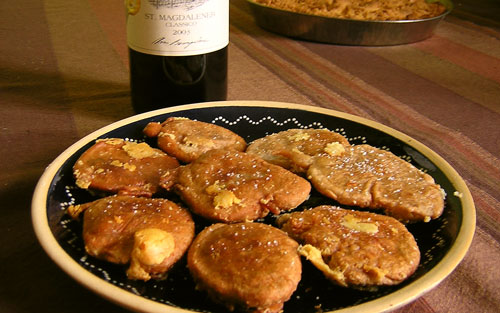
The sciatt were followed by the Mantuan riso alla pilota col puntel which kanljung mentioned before made according to the procedure I described before in this thread. To me, this is winter comfort food, so I'm not really able to be objective about the dish, though the ribs came out particularly nice this time. Instead of using the classic pan fry method, I followed a recipe from the cookbook of "dal Pescatore": which cooks the ribs in water, lemon juice and olive oil till the water is completely evaporated and then browns them shortly in the oven. The result are some extremely juicy and flavourful ribs.
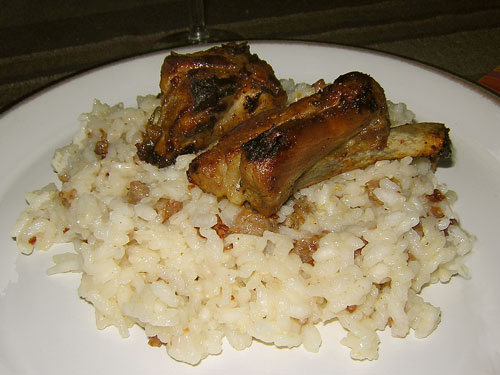
To finish with a sweet note (and more butter), I went for another Mantuan classic, torta sbrisolona, practically a cake made preparing a crumble of wheat and maize flour –flavoured with lemon peel and vanilla and mixed with coarsely chopped almonds– and sprinkling this on a cake mold. Simple, yet quite nice and even better when taken together a glass of sweet liqueur wine like vin santo or Marsala, though maybe not everyone's cup of tea (especially for those who love creamy desserts).
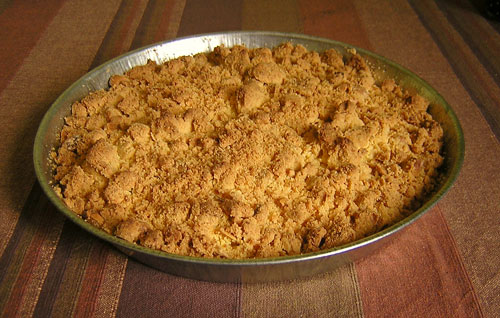
-
I also managed to dig out the recipe for salamelle Mantovane kanljung was writing about: 500g lean pork meat (from the shoulder or leg), 400g pork belly, salt, white pepper, a little nutmeg (for all three the recipe says "to taste"
 ) and a glass of red wine (infused with a finely chopped garlic clove and then filtered).
) and a glass of red wine (infused with a finely chopped garlic clove and then filtered).Thanks for the info, Alberto. This makes it close enough to my substitute of choice: A really good fresh italian sausage made in-house by one of the italian delis here in Gothenburg. The main difference is that is made with white wine instead of red.
I'm sure it will work perfectly. Just one suggestion that comes to mind:if I'm not mistaken, Ada Boni has a recipe for riso alla pilota with "standard" Italian sausage and she suggests to add just a pinch of cinnamon and nutmeg to get the flavour right. Might be worth a try.
If anyone wants to use the recipe I gave above, I have just made my first try and there are one or two tips I think could be useful:
- about a tablespoon salt is enough, and a teaspoon pepper.
- when you prepare the garlic flavoured wine do so the previous evening. I prepared mine today and left the garlic in the wine for about 3-4 hours. The end result was not as garlicky as it should be.
-
In Basilicata it can be called lucanica or lucania which are derived from the Latin lucanicus, said to be the name of a sausage invented by the Lucanians, an ancient people of southern Italy. This sounds a little bit of a fairy tale to me as there are similar names for sausages in many regions Longaniza and Llonganissafrom Spain and, like It is also mentioned in Apicius and by Varro and Cicero. There is also a Greek variation from Loukanika.
Adam, you can add this one to the list: a guy from the Italian speaking part of Switzerland I met camping a few years back was ready to bet his sleeping bag that luganega comes from the city of Lugano, hence the name, and that those thieving Lombards just stole the recipe from the Swiss
 .But there is a famous version that has developed in the last 2000 years in Lombardy around Monza and as we are doing food from Monza this is the veriosn I want a recipe for.
.But there is a famous version that has developed in the last 2000 years in Lombardy around Monza and as we are doing food from Monza this is the veriosn I want a recipe for."La Cucina Lombarda" by Alessandro Molinari Pradelli gives the following ingredients for the seasoning of Luganega di Monza: salt, white pepper, spices (either nutmeg or cinnamon) and grated Grana Padano, with Marsala optional. Unfortunately there's no amounts or ratios given.
I also managed to dig out the recipe for salamelle Mantovane kanljung was writing about: 500g lean pork meat (from the shoulder or leg), 400g pork belly, salt, white pepper, a little nutmeg (for all three the recipe says "to taste"
 ) and a glass of red wine (infused with a finely chopped garlic clove and then filtered).
) and a glass of red wine (infused with a finely chopped garlic clove and then filtered). -
Nathan, your food looks execellent as always!
I'm absolutely impressed too! Not only from the food, but also that you managed to find some Lambrusco Mantovano.
The recipe on the site I linked to above calls for a fresh Mantuan pork sausage called salamelle. What are the distinguishing features of this sausage? I guess I'll have to substitute this with some other fresh italian sausage.If you have a little patience I might be able to find a recipe for the forcemeat that makes the salamelle, I should have one in my cookbook collection at home. I definitely remember pepper, and garlic flavoured red wine as seasoning, but I'm sure there's something else. I hope to post it sometime tomorrow. Tonight I have a few guests over for a Sicilian inspired dinner: I tried to convince them to switch to Lombardia and use that as my first contribution to the thread, but fat chance.
The "col puntel" version sounds even more interesting. How are the ribs seasoned? Is the sausage left out from the riso alla pilota in this version?I have to check the seasoning, but I think it's just pepper and white wine. The sausage is definitely still in the riso alla pilota, traditional cooking has no waistline concerns
 .
. -
One interesting take on risotto is the Risotto alla pilota from Mantua. In this risotto the rice is boiled in water first and then sauteed together with fresh mantuan sausages. When I was looking for more info about this dish, I found a site with info about Mantua together with recipes. It is available in both english and italian.
Riso or risotto alla pilota –one finds both names in Italian sources– is definitely an interesting dish, both in its "basic version" and the richer one "col puntel" (the same dish served with oven-roasted pork-ribs). What baffles me is why so many sources insist on calling it a risotto. It lacks all the technical steps that make a risotto: no toasting of the rice, no use of broth, no stirring and no "mantecatura" with butter and Parmesan at the end.
The cooking method itself, which requires little attention and minimal active cooking time, reflects the origin of the dish as worker's dish: the rice is poured into the boiling water in a particular way (it should form a cone/pyramid that emerges from the water for about 1cm), cooked for about 10 minutes in the oven (in the past on the oven's embers), then let to rest, tightly sealed, till cooked. Only then is the meat and eventual Parmesan added. The dish was originally made by the "pilotti", the rice cleaners working the "pila" (the machine used in the process), hence the name.
Like many of the far Northern regions of Italy, Lombardia embraces risotto as its primo of choice. There is, of course, the famous, saffron-tinged risotto alla Milanese (another dish with many conflicting stories of its origin), the sine qua non accompaniment to osso bucco alla Milanese.Let's not forget the many stuffed pastas and polenta dishes from the region. Risotto is certainly important, but there's more options for those who are not that keen on rice.
-
Brad, thanks for the great wine-related input.
BTW, although we now moved to Lombardia, the Piemonte thread remains open for Piemonte related cuisine and gastronomic heritage, so feel free to add any info you feel like sharing there too.
Thanks!
-
Great, let's get cooking!
I'll probably be concentrating my efforts on the cuisine of Mantua and of Valtellina, though I'll definitely have a go at one or two Milanese classics, especially Casseula (the Milanese version of Cassoulet, if you wish to find a similar dish) if I manage to find a pig's head.
Mantua has a fascinating mix of rural cuisine, river fish recipes and Renaissance classics from the Gonzaga's kitchens... plus it's where my father's side of the family comes from, so it's a chance to revisit my childhood comfort foods. I'm a sucker for Mantuan cuisine
 .
.Valtellina, up next to the Swiss border, has a unique cuisine with loads of cheese, buckwheat and trout (not all together!). Oh yes, and some pretty nice wines like Inferno: one has to love a wine that's called Hell
 .
.On the technical thread side I should make two points:
- I would like to remind anyone who wants to post an image of a map of Lombardia, that as usual the image has to comply with our Copyright and Fair Use Policy.
- Since Kevin has volunteered to keep counts (poor him
 ) let's keep voting for future regions via PM to avoid cluttering the thread with unnecessary and off-topic talk.
) let's keep voting for future regions via PM to avoid cluttering the thread with unnecessary and off-topic talk. -
Without wanting to put my weight as a moderator behind one region or the other, I have to say that personally I prefer Friuli. It might be a great choice to experience how eclectic Italian regional cuisine can be and how "foreign" culinary influences have been assimilated into a region's cuisine.
Both Friuli and Trentino show a strong Venetian influence in their culinary tradition, but they are also quite different. Friuli is a mix of alpine cuisine, Mediterranean coastal cuisine, with Austrian and Slavic influences playing a big role. Trentino (especially when taken with Sudtirol) has two of these elements (alpine and Austrian), plus some very unique cooking from the local Ladino speaking community, but lacks a coast and a border to a Slavic-language speaking land.
-
Host's note:
As some of you will doubtlessly already have noticed, I have changed the title of this thread to "Cooking and Cuisine of Piemonte and Val d'Aosta" following the suggestion many of you have expressed both on this thread and in private. Since the thread is already so long it makes sense to dedicate a separate thread to the next region.
Even more important, at least for us hosts, is that having threads dedicated to the different regional cuisines of Italy was something we wanted to have for a while. It is great to see things lifting off thanks to the enthusiasm all of you have shown. Thanks for the great effort. I'm sorry I missed out on Piemonte but count me in from next month
 .
.With this in mind, I would kindly ask that whoever starts to post about Friuli does so in a separate thread called "Cuisine and Cooking of Friuli Venezia Giulia". The choice of the following month(s) should better be discussed in this new thread, and so for the following months (new thread for each new cuisine and discussion of the follow-up region in that thread). My intention is to leave the different regional thread open, even after the end of the month, allowing anyone interested in that particular cuisine to have a dedicated thread permanently available.
And now back to the interesting stuff: food!
-
The page Ore is pointing to is here. As much as I'd love to own the ilforno.com domain, I do not
 .
. -
Huh. I had Sacher Torte at the Hotel Sacher this summer, and didn't find it dry at all, but dense and moist, so you can add my vote to the small but happy minority.

I'll add myself to the list of Hotel Sacher's Torte appreciators, though I must admit my last and only Sacher goes back some eleven years.
The Torte I had back then was definitely moist and rich in chocolate and absolutely not too sweet (something I cannot stand in cakes). On the same trip I also tried Demel's Sacher, but found it slightly sweeter and therefore less to my taste. Makes me wonder if Hotel Sacher has changed
 the recipe somehow,
the recipe somehow, -
Adam,
could it be that you miss-tipped the dialect word? O' rraú is the Neapolitan for "il ragu".
regarding the cooking procedure: I personally use exactly the same method JC Francesconi describes though my ingredient list is slightly different and I do try new cuts of meat from time to time. On the other hand I've seen ragu prepared with quite a lot of fluid, but then using very long cooking times, 6-8 hours and more.



Torino Restaurants: Reviews & Recommendations
in Italy: Dining
Posted
well, there IS a snowboard among those chocolates .
.
Where did you take the pictures Ed?